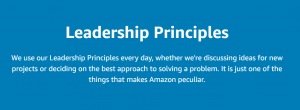Stefanie Potgieter graduated from our program in 2015 and now works as a  senior program manager with the Secure AI Foundations team at Amazon. Her role has several different components. She is the Business Operations Manager for an organization of 5,000+ employees worldwide. Her responsibilities also include executive communications, helping to define and execute a communication strategy for the organization’s vice president.
senior program manager with the Secure AI Foundations team at Amazon. Her role has several different components. She is the Business Operations Manager for an organization of 5,000+ employees worldwide. Her responsibilities also include executive communications, helping to define and execute a communication strategy for the organization’s vice president.
We asked Stefanie about communication and culture at Amazon and her jobs since graduation. She offers some excellent advice for every communicator, wherever they are on their career path.
What are the communication dynamics at a company with over a million employees?
 Unlike some of the other places I’ve worked, the communication resources at Amazon are staggering – it’s such a massive organization. We employ a wide range of digital communication technologies to connect with employees. The company intranet, email, Slack, newsletters, of course- Alexa, and more. Communication is constantly evolving as Amazon continues to grow.
Unlike some of the other places I’ve worked, the communication resources at Amazon are staggering – it’s such a massive organization. We employ a wide range of digital communication technologies to connect with employees. The company intranet, email, Slack, newsletters, of course- Alexa, and more. Communication is constantly evolving as Amazon continues to grow.
On my team, we do a few different things. Some of which include a virtual All Hands meeting as well as bringing leaders of our organization together twice a year for face-to-face interactions; this year the pandemic forced us to conduct virtually. A big part of my job is figuring out the who, what, when, where, and why. I help the team interpret, understand, and carry out the leadership’s vision and strategic intent. I plan for what topics employees want to hear about, training needs, circulating the organization’s vision, and aligning the team on our goals. The key is always how do we accomplish all of that while making it fun and engaging?
What is Amazon’s organizational culture like?
 You’ve probably heard of Amazon’s 14 Leadership principles. Deliver results, dive deep, earn trust, invent and simplify are just a few of them. These principles are infused into everything we do, wherever we work around the world. It’s amazing! I’ve never worked for a company that actually utilizes their principles in every facet of the Amazon work life and culture.
You’ve probably heard of Amazon’s 14 Leadership principles. Deliver results, dive deep, earn trust, invent and simplify are just a few of them. These principles are infused into everything we do, wherever we work around the world. It’s amazing! I’ve never worked for a company that actually utilizes their principles in every facet of the Amazon work life and culture.
At the same time, the organizations within Amazon also have distinctive cultures. When I was in our master’s program, I remember how we studied the concepts of organizational culture and climate. That conceptual basis helps you understand the culture you’re working within and how it influences peoples’ behaviors.
How do you make communication part of your job role?
When I graduated from our master’s program in 2015, I had a plan. I thought, “I’m going to go out and jump right into a communication role in some organization”. It didn’t turn out that way. The Los Angeles job market where I lived was so saturated, it was hard to get your foot in the door, and I struggled to find a communication-specific role.
So I ended up taking an executive assistant job at Motion Picture Licensing Company. The company had no communications department. I advocated for the value of communication and carved out a communication role for myself. It worked. In addition to my other responsibilities, communicating the company’s human resource initiatives, building an employee intranet, and building a culture worldwide became a huge part of my job. I loved it!
One piece of advice I have is this: Don’t just settle for a narrowly-defined role. If you’re passionate about communication, seek out opportunities to show how much impact it can have on employee morale and your organization’s performance. Identify the gaps, and come up with multiple ideas that you can present to fill those gaps. It never hurts to ask and I have found in most cases, people are grateful when you have identified a problem and are ready to pull the trigger on a solution.
How did your career path lead to Amazon?
 Amazon reached out and recruited me for an executive assistant role. My initial reaction was ‘I don’t want to get pigeon-holed in that job family’, but I figured it was a way to be part of a great organization and get my foot in the door. From there, I would try to again carve out a communications role.
Amazon reached out and recruited me for an executive assistant role. My initial reaction was ‘I don’t want to get pigeon-holed in that job family’, but I figured it was a way to be part of a great organization and get my foot in the door. From there, I would try to again carve out a communications role.
And that’s what happened. I kept saying, I want to do communications. I kept pushing and seeking out new opportunities within the company, leveraging my network, and learning all that I could. Then, I moved over to Alexa and into this business operations manager position, where I’m using my communication skills and knowledge to make a positive impact.
There are so many positions out there that may not be marketed as a traditional “communications” role, but project/program/product management, HR, business roles, all leverage communication in their own right. Take advantage of the opportunities that are presented to you in the moment, and then let your passion for communication demonstrate your value to the organization.
Posted by Stefanie Potgieter, CPS’15 and Carl Zangerl, Faculty